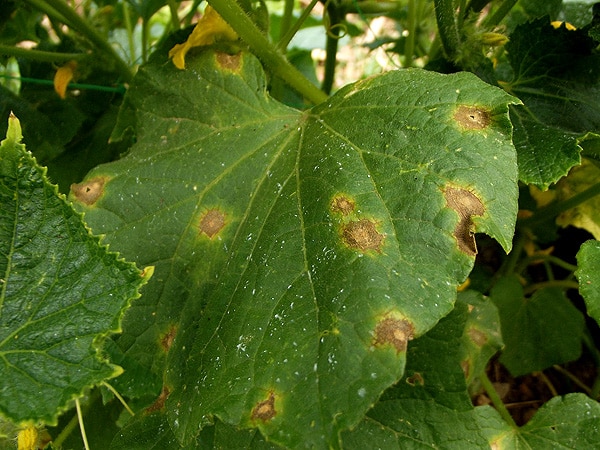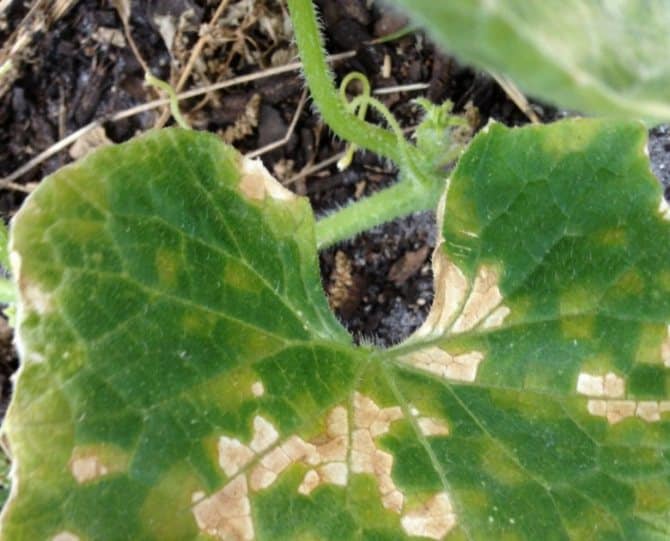Why do brown spots appear on cucumber leaves and what to do to get rid of them
When you start growing cucumbers, you may find various spots on the leaves. This is the first sign of an unhealthy plant. An advanced disease can lead to significant crop loss, so it is important to identify the cause and begin solving the problem as quickly as possible. We will tell you in this article what to do if brown spots appear on the leaves of cucumbers.
Causes of brown spots on cucumber leaves
The reasons for the appearance of spots on cucumbers can be different: improper care, pests, infectious diseases.

Downy mildew
Peronosporosis, or false powdery mildew, is an infectious rapidly progressing disease. In the absence of urgent treatment plants die.
First, light yellow or light green spots appear on the leaves in the form of a mosaic, then a gray coating with purple splashes appears. The leaves quickly turn brown, turn outward and dry out. The affected area grows, and eventually the plant dies. Cucumbers are susceptible to infection at any stage of growth.
If the fruits have already formed, they stop developing, acquire a white-green color, and become tasteless. With increased humidity, dense plantings and high temperatures, spores spread at high speed to neighboring plants.
Cladosporiosis
Cladosporiosis, or olive spot, is a fungal disease that affects all above-ground parts of the plant. First, small light gray spots appear on the leaves, then they acquire an olive-gray color with a light border along the edge. On the back of the leaf, dried spots are covered with cobwebs. Then they collapse, leaving holes in the leaves. Elongated dry gray spots form on the stems.
A gray-olive coating and depressed oily spots ranging in size from 5 to 15 mm appear on the fruits. Gradually the surface dries out and the flesh rots. Affected fruits become lumpy and may bend sharply at the site of the lesion.
Attention! In conditions of high humidity and low temperatures, cucumbers are more likely to be affected by fungal diseases. Do not overwater and cover plants during periods of prolonged rainfall.
Anthracnose
Other name anthracnose - copperhead. This is a fungal disease that affects the entire plant, but the fruits suffer the most. Seedlings develop depressed brown spots in the area of the root collar.
Light yellow or pale green small weeping spots first appear on the leaves of mature plants. Gradually they increase to 4 cm and become copper-brown. The entire leaf turns brown and becomes very brittle, and holes may form.

At high humidity, the leaf rots, and in dry weather it dries out. Ulcers appear on the fruits - oblong, depressed, weeping spots of light brown or pinkish color of different sizes. They grow and deepen up to 4 mm.
Cucumbers become bitter, darken, shrink and rot. Such fruits cannot be eaten. Yellow-brown oblong spots form on the stem, often they encircle the shoot, it breaks, and the plant dies.When humidity is high, the ulcers become covered first with a pink and then black coating.
Angular spot
Angular spot, or bacteriosis, affects the plant at any stage of development and growth. Infestation often appears from the lower or cotyledon leaves. Single angular wet spots form on the underside of the plate.
In wet weather, they secrete yellow mucus; in dry weather, the spots dry out and turn pale. On the front side of the leaf these places become pale yellow, then brown. After a few days they dry out and may perforate. If the affected area is large, the leaf crumbles, leaving only the veins.
The causative agent of the disease is transferred to the plant with rain, wind, remains of infected vegetation, contaminated tools during trimmings. The fruits slow down in development and lose their taste, rotting faster.
Important! Clean your tools often and wash your hands when working to avoid transferring pathogenic bacteria to neighboring plants.
Ascochyta blight
Ascochyta blight, or black stem rot, is a fungal disease that develops along with the plant. The spores are stored on the seeds, waiting for the right time. The disease affects the outer part of the plant, does not destroy it completely, but significantly worsens the condition and has a detrimental effect on the harvest. Doesn't show up for a long time.
The first signs are a gray coating on the stem. Gradually it turns into white spots, then black rot forms. When the fruits begin to grow, the lower tier of leaves turn brown. Gradually the disease rises up the plant. Affected cucumbers begin to wither and rot from the inside. Sometimes the fruits become covered with ulcers, rusty coating and mucus. Pathogenic spores are carried by the wind to neighboring plants.
Rhizoctoniosis
This fungal disease affects the basal part of the stem and cotyledon leaves, capturing the entire plant except the flowers. Leaves and fruits become covered with brown spots. First of all, the parts of the plant that touch the surface of the ground are affected.
Alternaria blight
Alternaria blight, or dry spotting of cucumbers, is a fungal disease. The main carrier of spores is aphids. Scattered small brown spots first cover the lower leaves of the plant, gradually increase in size and merge into a large spot, affecting half of the leaf blade. Due to disruption of the photosynthesis process, the development of plants and fruits slows down, worse ovaries are formed. Gradually, the disease covers the entire plant.
Why is there a problem in a greenhouse?

Cucumber is a very delicate crop that requires special attention and care.. To obtain the harvest earlier, the first plantings are done in greenhouses. Such shelter does not protect plants from diseases. An improper ventilation system can cause sudden temperature changes, and its complete absence leads to very high humidity. In such conditions (usually from 70%), most bacteria and fungi feel great and actively develop.
Important! Avoid drafts during ventilation. Try to do this during the warm part of the day.
Lack of light and dense plantings do not allow the plant to fully develop. Depleted soil, which does not change for several seasons in a row, accumulates fungal spores and larvae of various pests.
In the open ground
Outdoors, the risk of high humidity is less, unless the heavy rainy season has begun. However, there is a risk of sudden temperature changes during the day and night.An improperly organized irrigation system can also lead to rotting or, conversely, drying out of plants, which will weaken them and make them more vulnerable to pests and pathogens.
How to get rid of brown spots

In some cases, generous treatment of the affected areas with iodine solution helps stop the development of the disease. In 1 tbsp. 2 drops of the drug should be mixed with water and treated immediately, without allowing it to dry out.
Purchased funds
Industrial preparations are divided into fungicides (antifungals) and insecticides, acaricides (to control insects).
The first include Bordeaux mixture, copper sulfate, Fitosporin, Hom, Kvardis, Ridomil Gold, etc. Some of them can be used in conjunction with insecticides.
In the fight against insects, the drugs Iskra, Fitoverm, Actellik, Komandor, etc. have proven themselves well.
Traditional methods
If the disease is detected at the initial stage, you can try to defeat it with folk remedies. They are harmless, cheap, and easy to prepare.

How to treat:
- A good remedy for cucumber diseases is woody ash. You can dust plants with it and sprinkle the soil around them. You can prepare a solution from 1 tbsp. ash and 10 liters of water, let it brew for one day, spray and water the cucumbers at the root. This tool also serves feeding.
- In some cases, generous spraying of mustard helps. To do this, dissolve 2 tbsp in 10 liters of water. l. mustard powder.
- A light pink solution of potassium permanganate is widely used. You can regularly spray and water the plants with products containing iodine and brilliant green: 20 drops of each product per bucket of water.
- The causative agents of many diseases die from an acidic environment.To do this, mix 1 liter of whey in 10 liters of water. Cucumber plantings are thoroughly irrigated with this solution. The same solution is made using milk and a few drops of iodine in a bucket of water.
- To prepare a medicinal solution, you can infuse celandine, dandelions, onion peels or chopped garlic in water for several days.
During treatments, try to cover the area around the cucumber plantings. Pests can also enter plants from neighboring areas.
Timing and frequency of treatments
Treatments with purchased products are carried out strictly following the instructions, observing the dosage, timing and time of day (some work more effectively with morning treatment, others with evening treatment). These are powerful tools, so 2 procedures are often enough.
Treatments with folk remedies must be carried out throughout the season. Do this regularly, every 7-10 days. To prevent large losses, plants are inspected daily; if signs of disease are detected, the affected parts are removed and treatments begin immediately. With a large scale of infection (more than 1/3 of the plant), special chemicals are no longer necessary. If the plant is 2/3 or more affected, it must be removed and burned.
Rules
An important condition for the proliferation of harmful bacteria and fungi is high humidity. For more successful results in the fight against them, watering must be stopped for 2-4 days or reduced. It is not only the affected part that needs to be treated. Spores and bacteria could settle in the soil and on the inside of the greenhouse.
Preventive measures

Before planting, the seeds are soaked in a light pink solution of potassium permanganate. It is not recommended to thicken the plantings; maintain a distance of at least 15-20 cm. Preventive treatments with folk remedies begin with the appearance of the second leaf. Use spraying and root feeding with nitrogen fertilizers and mullein infusion (1 liter per 10 liters of water).
After the last harvest, all plant residues are burned. In the greenhouse, not only surfaces are washed and treated: microorganisms accumulate in cracks and joints, so special attention is paid to such secluded places. The top layer of soil needs to be replaced periodically.
Attention! Favorable predecessors of cucumbers - rye and oats.
Advice from experienced gardeners
To enjoy a good harvest, grow varieties that are resistant to diseases and temperature changes. Choose well-lit, sunny places for planting, avoid drafts. Water and treat cucumbers only with warm water. The plant needs a constant supply of nutrients; alternate regular feedings and treatments with different formulations. The first ovaries and stepsons better pinch for a larger harvest.
Conclusion
Cucumber is a very capricious and delicate crop. To obtain a good harvest over a long period of time, plants should not be left to grow on their own. It is important to observe crop rotation and care rules. If signs of diseases are identified in time and treatment is started, up to 50% of crop losses can be avoided.